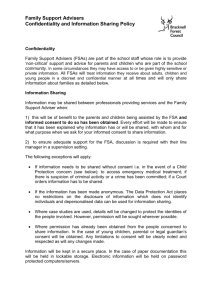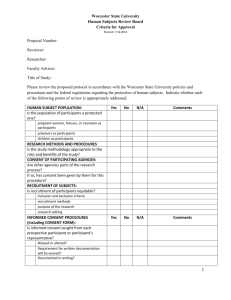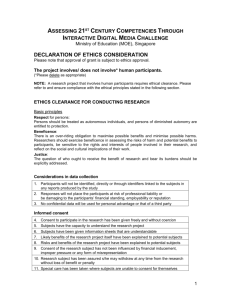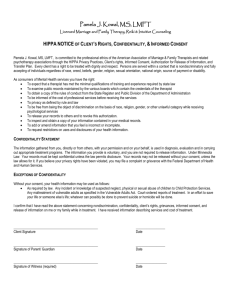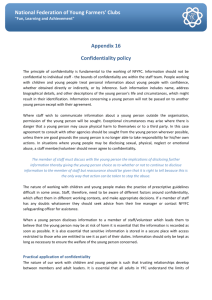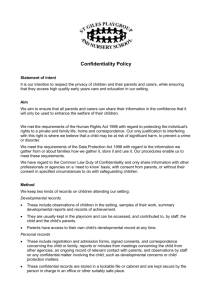Thalea's Test Slide Show
advertisement
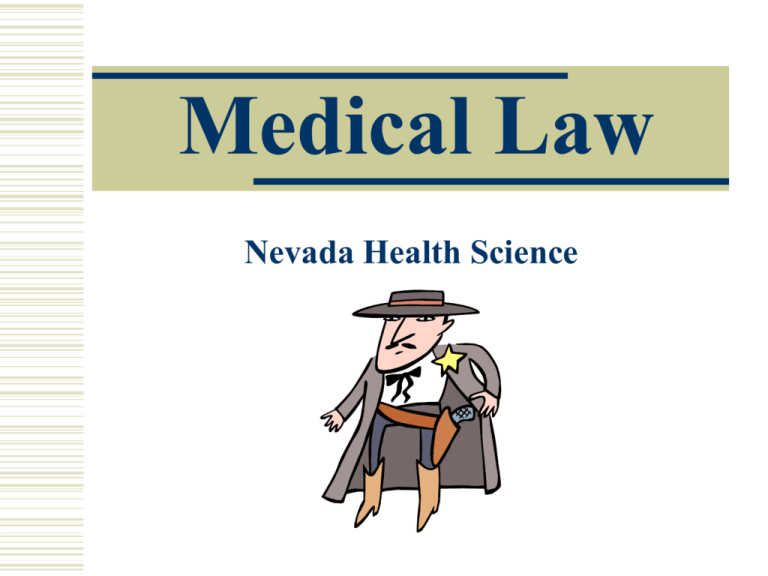
Medical Law Nevada Health Science Introduction In every aspect of life, there are certain laws and legal responsibilities formulated to protect you and society. Example: Traffic laws when driving a motor vehicle. Health care workers also have certain laws and responsibilities. Legal responsibilities are those that are authorized or based on law Introduction Health care workers are required to know and follow state laws that regulate their respective licenses or registrations or set standards for their respective professions. Failure to meet your legal responsibilities can result in legal action against you and your employer. Use problem-solving techniques when confronted with legal dilemmas or issues. American Legal System The U.S. Constitution separated the government’s power into three branches. Legislative Executive Judicial The legislative branch (Congress) is considered the law making body. The judicial branch interprets these laws. Sources of Law Laws/rules can come from four different sources: Constitutional Statutory Regulatory Common or Case Law Laws are also classified as private and public. Constitutional Law U.S. Constitution and Constitutions of the individual states. Sets up a government, defines the government’s power to act, and sets limits on the government’s power. Only addresses the relationship between individuals and the government; does not apply to private entities. Statutory & Regulatory Law Laws passed by legislative bodies, either Congress or the state legislatures. Inviolable rights, privileges, or immunities secured and protected for each citizen by the U.S. Constitution. Legislatures sometimes authorize agencies to make laws = regulations. Example: Food & Drug Administration. Common/Case Law Established from a court decision, which may explain or interpret the other sources of law. Also defines other legal rights and obligations. Based on precedent – ruling in an earlier case that is then applied to subsequent cases. Must be reviewed to determine if it is still justified and relevant. Ultimate interpreter of common law is the state supreme court/U.S. Supreme Court. American Legal System Federal law has precedence over state laws. State laws have precedence over city or municipal laws. State or city may make laws and regulations more stringent than the federal law, but they cannot make laws less stringent. Public (Criminal) Law Protect the public as a whole from the harmful acts of others. Wrongs against a person, property or society. Felonies – carry a punishment of death or imprisonment in a state or federal prison. Example: murder, rape, robbery, tax evasion, practicing medicine w/o license, misuse of narcotics, theft. Misdemeanors – less serious offenses that carry a punishment of fines or imprisonment in jail for up Civil (Private) Laws Concerns relationships between individuals and the protection of a person’s rights. Generally carry a monetary damage or award. Tort Law – acts that result in harm to another either intentional or unintentional. Contract Law – enforceable promises and agreements between two or more persons to do or not to do a particular action. Healthcare employees are most frequently involved in cases of civil law. Torts Tort – a wrongful act that is committed against another person or property that results in harm. Patient must have suffered a mental or physical injury caused by the provider. If a wrongful act has been committed and there is no harm, then there is no tort. Intentional and Unintentional harm. Intentional Torts Assault – threat of bodily harm to another; no actual touching. Threaten to perform a procedure w/o informed consent. Battery – actual bodily harm to another person without permission. Perform a procedure w/o informed consent. False Imprisonment – unlawful restraint. Keeping a patient hospitalized against their will, applying physical restraints without authorization. Intentional Torts Defamation of character – damage caused to a person’s reputation through spoken or written word. Negative statement about another’s ability. Slander: spoken. Libel: written. Abuse – any care that results in physical harm, pain or mental anguish. Physical, verbal, psychological, financial, or sexual. Domestic, child, elder abuse. Health care workers are required to report any signs or symptoms of abuse. Intentional Torts Fraud – deceitful practice. Promising a miracle cure. Invasion of privacy – unnecessarily exposing an individual or revealing personal information about an individual without that person’s consent. Violating patient confidentiality. Improperly draping a patient during a procedure so that other patients or personnel can see the exposed patient. Unintentional Torts Standard of care – professional must exercise the type of care that a “reasonable” person would use in a similar circumstance. Negligence – failure to give care that is normally expected of a person in a particular position, resulting in injury to another person. Examples: falls, using defective equipment, burns or infections caused by improper treatment. Unintentional Torts Malpractice – “bad practice”, professional negligence. Failure of a professional to use the degree of skill and learning commonly expected in that individual’s profession, resulting in injury, loss, or damage to the person receiving care. Examples: not giving a tetanus shot to a patient with a puncture wound, performing a medical procedure without proper training. Contract Violations A contract is an agreement between two or more parties. Offer, acceptance, consideration. Breach of contract – failure, without legal excuse, to perform any promise or to carry out any of the terms of a contract. In order for the contract to be valid, both parties must be competent/free of legal disability. Contracts can either be expressed (oral or in writing) or implied (understood without verbally expressed terms). Contract Violations Examples Abandonment – once a provider has agreed to take care of a patient, that contract may not be terminated improperly. Most contracts are enforceable, even if oral. Risk Management Derived from law and professional standards. Expressed through institutional policies/practices. Linear Model: Ethics Law Identification of values – what ought to be Expression of values in social rules Risk Management Choices to reduce potential liability Risk Management Generally healthcare facilities employ a risk manager. Usually the risk manager is an attorney with a clinical medicine background. Their job is to reduce the risk of liability through institutional policies/practices. Quality in all aspects of patient care. Education of all employees. Monitor activities resulting in loss of time, equipment, and resources. Compliance with rules and regulations. Timely reporting of quality issues and adverse Risk Management Example: Operating Rooms If you were a risk manager in a hospital that continued to have problems with surgeons leaving sponges inside a patient after surgery, what are some new procedures you could implement to stop this from happening? Documentation A record of the patient’s progress throughout treatment. Many people are responsible for documenting information on patients. Documentation must be accurate, concise, and complete. Writing should be neat and legible. Spelling and grammar should be correct. Documentation All records must contain certain information: Patient name, address, age, identification #. Diagnosis and physician’s orders. Other information may be required: Care or treatment given and how patient tolerated it. Time of treatment. Observations that would be helpful to other health care workers. Documentation All documentation must be signed with the name and title of the person recording the information. The date and time that the documentation is being made should also be recorded. Errors should be crossed out neatly with a straight line, have “error” recorded by them, and show the initials of the person making the error. Documentation cannot be your opinion or interpretation. All observations should be stated as subjective or objective information. Patient documentation is a legal record, admissible in a court of law. Documentation If you do not write it down, it did not happen! Use ink for all documentation. Entries should be in short phrases. You do not need to write in complete sentences. Time should be recorded in military (24 hour) time. Non-Discrimination Laws Patients have the right to considerate and respectful care from all members of the health care system at all times and under all circumstances. An environment of mutual respect is essential to maintain a quality health care system. Incidences of discrimination – real and perceived – mar the relationship between patients and their health care providers. Non-Discrimination Laws Providers and health care agencies must not discriminate against patients because of race, ethnicity, religion, ancestry, marital status, sexual orientation, national origin, age, gender, physical or mental handicap, genetic information, or source of payment. Respect Respect is defined as recognizing a person’s capacities and perspectives, including their right to hold certain views, make choices, and take actions based on personal values and beliefs. Examples of disrespect in health care: Poor communication with providers. Feeling rushed or ignored. Lack of dignity during examinations. Extensive waiting room delays. Receiving inadequate explanations or advice. Feeling that complaints are not taken seriously. Patient Rights Federal and state laws require health care agencies to have written policies concerning patients’ rights or the factors of care that patients can expect to receive. Agencies expect all personnel to respect and honor these rights. Health care workers can face job loss, fines, and even prison if they do not follow and grant established patients’ rights. These rights ensure the patient’s safety, privacy, and well-being, and provides quality care. Patient Rights The American Hospital Association has affirmed a “Patient’s Bill of Rights” that is recognized and honored by many health care facilities. All states have adopted these rights and some have added additional rights. It is important to check state law and obtain a list of rights established in your state. Patient Responsibilities The collaborative nature of health care requires that patients and/or their families participate in their care. Patients have rights as well as responsibilities. Provide information about past medical history. Participate in decision-making. Ask for information and/or clarification if they do not fully understand. Patient Responsibilities Cont. . . Inform providers if they anticipate problems in following prescribed treatment. Be aware of agencies obligation to be reasonably efficient and equitable in providing care to other patients. Provide necessary information for insurance claims and working with the agency to make payment arrangements. Informed Consent The patient must have an opportunity to be an informed participant in their health care decisions. The following elements should be discussed: Nature of the decision/procedure. Reasonable alternatives to the intervention. Relevant risks, benefits, and uncertainties. Assessment of patient understanding. Acceptance of the intervention by the patient. Informed Consent The patient must be considered competent to make the decision at hand. Consent must be voluntary. Most states have legislation or legal cases that determine the required standard for informed consent. Most agencies have policies that state which health interventions require a signed consent form. If the patient cannot give informed consent, a surrogate decision maker must speak for them. Hierarchy of appropriate decision makers is defined by Medical Law In the course of providing healthcare, a range of legal issues may arise. It's all tied together: legal, risk management, and ethical issues. Law is dynamic - in a constant state of change. Medical Law Common medical law issues: Access to medical care Informed consent Confidentiality of information Privileged communication Advanced directives Physician-assisted suicides Medical mistakes Case #1 32 yo woman admitted to Trauma Intensive Care Unit following a serious motor vehicle accident. She has multiple injuries and fractures with several complications. She is now on a ventilator and is continuously sedated. Case #1 Patient's parents are vigilantly at her bedside. Parents report that patient is 1 month away from having her divorce finalized. Husband was reportedly physically and emotionally abusive. No one has notified the husband. Who is responsible for treatment decisions which the patient cannot make? What are the legal and ethical parameters? Case #1 - Discussion Informed consent and surrogate decision-making. Patient's own statements/consent may be the basis for ongoing care. It is likely there is a temporary court order in effect which may remove the estranged husband from making medical decisions for her. May also have a restraining order. Health care facility can contact the divorce lawyer for appropriate paperwork. Case #1 - Discussion Any surrogate decision-maker is legally required to act in accordance with the patient's wishes. If substituted judgment isn't possible, then must act in patient's best interest. Any decision which doesn't adhere to this standard is usually reviewed by risk management and/or ethics committee. Patient's parents may file to become the patient's legal guardians for healthcare decision-making. Case #2 72 yo woman admitted to Neurocritical Care Unit following cerebral hemorrhage which left her with severe brain damage and ventilator dependency. Patient & husband had previously drawn up living wills specifying that she did not want artificial life support in the event of a terminal illness or permanent vegetative state. Patient's husband is legal next of kin - has surrogate decision-making authority. Case #2 Husband insists that the patient had not intended for the document to be used in a situation like this. He believes her situation is not terminal even though she will not be able to recover any meaningful brain function. Husband is unwilling to withdraw life support measures consistent with patient's wishes. What should be done? What are the legal implications? Case #2 - Discussion Informed consent, surrogate decision-making, advanced directives. If additional communication with the husband fails to resolve the impasse - one option is to go forward with the withdrawal of life support. Affirm consensus - patient's lawyer & medical team. Set conference with family to review prognosis & decision. This allows family an opportunity to seek legal review or arrange for a transfer to another health care facility. Patient Confidentiality By law all personal medical information must be kept private – privileged communication. Patients share private information with healthcare providers. You have a duty to respect the patient's trust and keep this information private. This requires restricting access of others to private information. Patient Confidentiality A trusting environment can encourage the patient to be as honest as possible. Obligation prohibits the healthcare provider from disclosing information about the patient's case to other parties. Discussions critical for patient care are an integral part of patient care. Patient Confidentiality Health Insurance Portability & Accountability Act (HIPAA) of 1996. Took effect on April 14, 2003. First ever federal privacy standard to protect patients’ medical records and other health information. Provides patients with access to their medical records and more control over how their personal information is shared. Protects all information – computerized or on paper or oral communication. Patient Confidentiality No identifiable information about patients should appear on shared documents. Do not talk about patients in public places where others may overhear. Do not use the patient’s name if others in the room might overhear. Use caution about giving results over the phone or about leaving messages. Don’t leave charts or reports where others can see them. Patient Confidentiality When can it be breached? Not an absolute obligation. Situations arise where the harm in maintaining confidentiality is greater than the harm brought about by disclosing the information. Exceptions: Concern for the safety of other specific persons (homicidal ideation). Concern for public welfare (communicable diseases, abuse, gunshot wounds). Patient Confidentiality What about sharing information with family members? Without explicit permission from the patient it is generally unjustifiable to do so. Except in cases where the spouse is at specific risk of harm directly related to the diagnosis, it remains the patient's privilege. Patient Confidentiality The growing use of computerized medical records has created a dilemma in maintaining confidentiality. Limit personnel who have access to records. Use codes/passwords to prevent access to certain information. Monitor and evaluate computer usage. Case #3 A 75 yo woman shows signs of abuse that appear to be inflicted by her husband. As he is her primary caregiver, she feels dependent on him and pleads with you not say anything to him about it. How would you handle this situation? Case #3 - Discussion The laws supporting elder abuse and child abuse allow you to break confidentiality and report suspected abuse. If you think it is possible to give this woman support and access to other services without reporting the case immediately - you have an obligation to address her abusive situation. Case #4 60 yo man has a heart attack and is admitted to the medical floor with a very poor prognosis. He asks that you do not share any of his medical information with his wife as he does not think she will be able to take it. His wife catches you in the hall and asks about her husband's prognosis. Would you tell his wife? What are you required to do legally? Case #4 - Discussion Duty to maintain confidentiality remains strong in this case as information about the patient's health does not directly concern others' health, welfare, or safety. The wife is certainly affected by her husband's health and every effort should be made to encourage an open dialogue between them. However - it remains the patient's responsibility to do so. Do Not Resuscitate (DNR) Orders If the patient stops breathing or their heart stops beating, the standard of care is to perform CPR. There are situations under which CPR can be withheld. When CPR is judged to be of no medical benefit - medical futility. When the competent patient clearly indicates that he/she doesn't want CPR, should the need arise. Do Not Resuscitate (DNR) Orders If the patient understands their condition and possesses intact decision-making capacity, their request should be honored. It is a patient's right to refuse treatment. If the family disagrees with the DNR order, every reasonable effort should be made to communicate with the family. Do Not Resuscitate (DNR) Orders "Slow Codes" A half-hearted effort at resuscitation is made. Not ethically justifiable. Undermines the rights patients have to be involved in clinical decisions and violates the trusts patients have in us to give our full effort. Case #5 An 81 yo woman with recurrent colon cancer and liver metastases is admitted to the hospital for chemotherapy. Because of her poor prognosis, you approach her about a DNR order but she requests to be a "full code“. Can you write the DNR order anyway? Case #5 - Discussion Studies show that metastatic cancer has a 0% chance of survival - thus CPR could be considered futile. Nevertheless, one should not write a DNR order, even if CPR is judged to be futile. Periodically readdress the CPR question with her. End Of Life Issues A "good death" is not a familiar idea in American culture. An ethically sound understanding of withdrawing and withholding treatment is crucial to good care of the dying. To provide excellent care of the dying requires that we also decide what we should do - not just what we don't do. End of Life Issues What should be the goals of medical care for people who are dying? In caring for a person who is dying, knowing what would make the experience of dying good is an important goal for providers. Listen more, talk less. We can't always help the patient with everything, but we can help them get ready to die. End of Life Issues Clinical goals when caring for someone near the end of life. Control of pain and other physical symptoms. Involvement of people important to the patient. A degree of acceptance by the patient - doesn't mean they like what is going on, just that the can be realistic. Medical understanding of the patient's disease. Process of care that guides patient understanding and decision-making. End of Life Issues Hospice - Multidisciplinary teams that go to patients' homes to provide end of life care. Pain Symptom control Psychological issues Spiritual or existential issues Often underutilized. Medical Mistakes Errors are inevitable in the practice of medicine - sometimes they result from medicine's inherent uncertainty or occasionally they are the result of mistakes or oversights on the part of the provider. In either case, healthcare providers will face situations where they must address mistakes with a patient. Medical Mistakes Do providers have an ethical duty to disclose information about medical mistakes to patients? Yes, regardless of whether the patient suffers serious consequences. Providers must deal honestly with the patient and act in their best interest. Must have ethical justification for withholding information about mistakes. Medical Mistakes It has been shown that patients are less likely to consider litigation when they feel they have been dealt with honestly. If you witness another provider making a mistake, you have some obligation to see that the truth is revealed to the patient. Clarify the facts of the case first. Case #6 An 18 month old child presents to the clinic with a runny nose. She is otherwise well and the immunizations due at 18 months are administered. After she and her mother leave, you realize that the patient was in the clinic the week before and had also received immunizations then. Should you tell the parents about the mistake? Case #6 - Discussion Even though the error is a trivial one and no harm will result, an open and honest approach to errors is appropriate. Case #7 A 3 month old has been admitted to the hospital with a newly diagnosed heart defect. He is in early congestive heart failure and Digoxin is indicated. You write an order for the drug. 30 minutes later the baby vomits, goes into cardiac arrest and dies. You discover that in writing the Digoxin order you misplaced the decimal point and the child got 10 times too much medication. What is your duty here? Will you get sued if you tell the truth? Case #7 - Discussion You owe this family an honest explanation - they need to hear you say you're sorry. Any attempt to hide the details of the event would be dishonest, disrespectful, and wrong. A lawsuit may or may not follow. Case #8 A 3 yo presents to the Emergency Department. She was diagnosed yesterday by her family physician with an acute kidney infection, treated with antibiotics and sent home. She is now vomiting and unable to keep the antibiotic down. You feel she should have been admitted yesterday. Should you tell the parents their physician made a mistake? Case #8 - Discussion The practice of medicine is not an exact science frequently providers will disagree about the most appropriate management of a case. Simply because you would have managed a patient differently does not mean the other physician made a mistake. In situations where standard practice varies, the parents need not be told that a "mistake" has been made. Parental Decision Making Adult patients have the moral and legal right to make decisions about their own medical care. Because young children are not able to make complex decisions for themselves, the authority to make medical decisions on behalf of a child usually falls to the child's parents. This includes the right to refuse or discontinue treatments, even those that may be life-sustaining. Parental Decision Making Parental decision-making should be guided by the best interests of the child. Decisions that are clearly not in a child's best interest can and should be challenged. Medical caretakers have an ethical and legal duty to advocate for the best interests of the child when the decisions may be dangerous to the child's health, neglectful, or abusive. Parental Decision Making When parents are not available to make decisions, medical caretakers may provide treatment necessary to prevent harm to the child's health. Children with the developmental ability to understand what is happening to them should be allowed to participate in decisions about their care. Parental Decision Making Minors have the authority to make medical decisions for themselves when they become “emancipated”. Self-supporting and not living at home. Married. Pregnant. A parent. In the military. Also, most states allow treatment without parental consent for STD’s, pregnancy, and drug or alcohol abuse. Case #9 4 yo with an obviously broken forearm is brought to the emergency department by her baby-sitter. Both the baby-sitter and ER staff have attempted to reach her parents without success. Can you treat this child without parental permission? Case #9 - Discussion Your first duty is to the health and welfare of the child. Having attempted to reach her parents, you should proceed with x-rays and treatment of her fractured forearm. Rapid treatment of the pain and fracture are clearly in her best interests. Case #10 An ill-appearing 2 yo with a fever and stiff neck appears to have meningitis. His parents refuse a lumbar puncture on the grounds that they have heard spinal taps are extremely dangerous and painful. What are you obligations in this case? How should you proceed? Case #10 - Discussion A lumbar puncture is the only way to diagnose meningitis and any delay in treatment could cause significant harm to the child. Weigh risks vs. benefits. A second opinion from another physician may prove helpful. Obtain an ethics consult or even a court order. Case #11 5 yo child has just had his second grand mal seizure in a 4 month period. You have recommended starting an anti-convulsant. Parents have concerns about the recommended medication and would prefer to wait and see if their son has more seizures. How should you respond to the parent’s request? Case #11 - Discussion Parents have the authority to make a choice of this sort – the decision does not appear to place the child at considerable risk. Though you may not agree with their decision, the decision is a reasonable one that doesn’t place the child at substantial risk of increased harm. Truth-Telling & Withholding Information Patients place a great deal of trust in their healthcare providers and may feel that trust is misplaced if they discover or perceive lack of honesty and candor by the providers. There are situations in which the truth can be disclosed in too brutal a fashion, or may have a terrible impact on the patient. Truth-Telling & Withholding Information Giving patients truthful information helps them to become informed participants in important healthcare decisions. Patients should be told all relevant aspects of their illness, including the nature of the illness, expected outcomes, treatment alternatives, risks and benefits of treatment, and other relevant information. Truth-Telling & Withholding Information Appropriate sensitivity to the patient’s ability to digest complicated or bad news is also important. If the provider has some compelling reason to think that disclosure would create a real and predictable harmful effect on the patient, it may be justified to withhold truthful information. Truth-Telling & Withholding Information Sometimes families will ask the provider to withhold a terminal or serious diagnosis or prognosis from the patient. Their desire is to spare their loved one the potentially painful experience of hearing difficult facts. Truth-Telling & Withholding Information There are two main situations in which it is justified to withhold the truth from a patient. If the provider has compelling evidence that disclosure will cause real and predictable harm – therapeutic privilege. Depressed patient to become actively suicidal. If the patient states an informed preference not to be told the truth. Truth-Telling & Withholding Information What about patients with different religious or cultural beliefs? There are various beliefs about the appropriateness of truthful disclosure. One should not assume that someone of a particular background holds different beliefs. Rather, a culturally sensitive dialogue about the patient’s role in decision-making should take place. Truth-Telling & Withholding Information Is it justifiable to deceive a patient with a placebo? A placebo is any substance given to a patient with the knowledge that it has not specific clinical effect, yet with the suggestion to the patient that it will provide some benefit. Placebo effect is very powerful! 20-30% of patients have measurable improvement. Truth-Telling & Withholding Information In general, the deceptive use of placebos is not ethically justifiable. Specific exceptions should be rare and only considered if the following conditions are present: Condition is known to have a high placebo response rate. Alternatives are ineffective and/or risky. Patient has a strong need for some prescription. Case #12 65 yo man with complaints of abdominal pain that is persistent but not extreme. Workup reveals that he has metastatic cancer of the pancreas. Patient has just retired and he and his wife are about to leave on an around-the-world cruise. Should you tell him his diagnosis or wait until he returns from the trip? Case #12 - Discussion Concern that the patient would suffer psychological harm that would interfere with his planned trip – not sufficient grounds to withhold the information. Sensitive disclosure would allow the patient to make informed decisions and spare the patient the inconvenience of suffering advancing symptoms while traveling. Case #13 80 yo Asian woman is hospitalized with weight loss, generalized weakness, and a pulmonary mass. Work-up reveals that she has pulmonary tuberculosis. Family approaches the provider and asks that the patient not be told, stating that in her upbringing in China, TB was considered fatal and to tell her would be like giving her a “death sentence”. Should you respect the family’s concerns? Case #13 - Discussion Family has a desire to show respect and protect the patient from harm. Their beliefs should be respected and a mechanism for informed decision-making in collaboration with the family negotiated. Provider should make an attempt to explore the patient’s belief system – if she does hold such beliefs then it would be justifiable to withhold the diagnosis. Mandated Standards A health care worker is responsible to maintain a safe environment. Your employer is also obligated to provide a safe environment. The Occupational Safety and Health Administration (OSHA) determines, develops, and monitors safe practices for each industry. OSHA will penalize employers for unsafe environments (large fines and lock outs). If you are at fault for not providing safe conditions, you could be fired. Mandated Standards The Centers for Disease Control (CDC) also regulates health and safety for health care workers as well as populations across the U.S. and the world. Additionally, the CDC has mandated Clinical Laboratory Improvement Amendments (CLIA) that regulates all laboratory testing performed on humans in the U.S. The objective is to ensure quality laboratory testing. Mandated Standards All organizations also have mandated standards for harassment (for both employees and patients). Labor and employment laws must also be followed by all health care agencies. Examples include payment of overtime, lunch breaks, age of workers, etc. Policies and Procedures Each health care facility or agency has a policy manual that explains their rules and regulations including: Holiday and vacation policy. Insurance and sick leave benefits. All other information concerning the operation of that business. These manuals include guidelines that workers must follow to do their jobs correctly. Conclusion It is important to remember that you are liable, or legally responsible, for your own actions regardless of what anyone tells you or what position you hold. It is your responsibility to learn exactly what you are legally permitted to do and to familiarize yourself with your responsibilities. Standards vary by state and health care agency. Conclusion The first responsibility of healthcare providers is to always provide competent and courteous care to patients. The three C’s: Courtesy Compassion Common sense You must learn to perform only those duties within your scope of practice at a reasonable standard of care.
